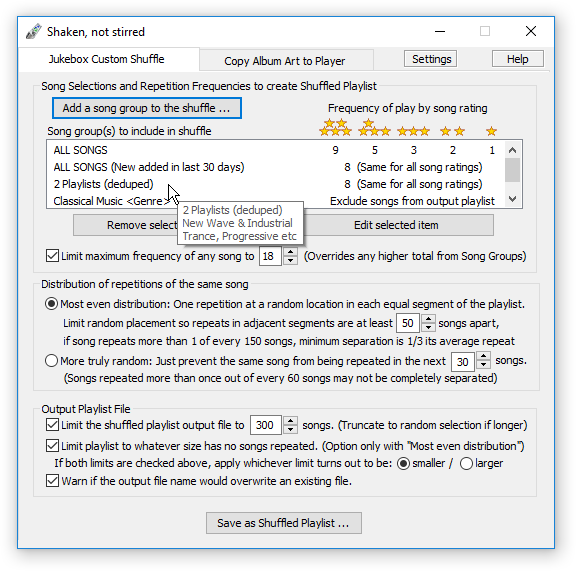 |
Shaken, not stirred |
Download Latest Version 3.3 Quick Start Instructions F. A. Q. Screen Shots Copy Album Art to Player Question/Comment for Author |
 |
Shaken, not stirred |
Download Latest Version 3.3 Quick Start Instructions F. A. Q. Screen Shots Copy Album Art to Player Question/Comment for Author |
Shaken, not stirred is a free Open Source jukebox program for people who like to hear some songs played on their phone or PC very often, and other songs only occasionally. The frequency of play is based on the 1 to 5 stars rating you assign in Windows Media Player, on your Windows PC. (Sorry, no Mac or Linux version)
The program generates shuffled playlists by randomly selecting songs from your entire collection, new songs, specified genres and/or existing playlists, or from any combination of those as you choose. How much more often your favored songs are played, and how repetitions are separated, are options controlled by the user.
Note: This DOES NOT generate playlists for Spotify or any other streaming music service. It only generates playlists from music saved on your PC, which you may also copy to your phone.
The random playlist can be created in .wpl format for syncing to your phone or MP3 player from Windows Media Player or Android sync app, or in the more generic .m3u format (Unicode or ANSI) for other sync programs like iTunes.
Shaken, not stirred also includes a separate utility (that you probably don't need) to copy album art from your computer to your phone or player, described on its own page.
 The
program uses Windows Media
Player's database to know what songs are in your collection, and what
their ratings are for setting how often to play each song. If you use
Windows Media Player to sync your player, and have assigned song
ratings (1 to 5 stars), no preparation is needed and you can generate
shuffled playlists with Shaken Not Stirred a few
minutes after
you download it. If you don't use Windows Media Player, some extra
steps are required, described in the
F.A.Q.
and more fully in the program's Help.
The
program uses Windows Media
Player's database to know what songs are in your collection, and what
their ratings are for setting how often to play each song. If you use
Windows Media Player to sync your player, and have assigned song
ratings (1 to 5 stars), no preparation is needed and you can generate
shuffled playlists with Shaken Not Stirred a few
minutes after
you download it. If you don't use Windows Media Player, some extra
steps are required, described in the
F.A.Q.
and more fully in the program's Help.
For a simple example of what it's like to use this program, see the Quick Start Instructions, copied from the program's help file.
The selection example in the illustration to the right is more complicated than you'd probably use, just to show some of the program's capabilities. The first item in the list "Song groups to include in shuffle" is ALL SONGS in your collection, with songs rated 5-stars played nine times as often as 1-star songs. This might be all you want to create a playlist, maybe choosing different frequencies, without bothering to add the other groups in the example list.
In the second group, the user sets all new songs added to the collection in the last month to play more often than older songs with the same stars ratings. These new songs are already included as part of ALL SONGS, so their play frequency is in addition to how often they would be played based on their song ratings in ALL SONGS.
The third group, "2 playlists (deduped)", sets some club-music to also play more often.
The last group included in the shuffle is songs to filter out of the generated playlist. In this example, the user likes to play Classical music some times, but doesn't want it included in this mixed playlist of their other types of music. No songs with the genre "Classical" will be in the generated playlist, even though they are part of the "ALL SONGS" group included in the shuffle.
The checkbox to "Limit maximum frequency ... to 18" would, for example, prevent a 5-star song that was also added in the last 30 days and is in one of the selected playlists, from playing more than twice as often as an ordinary 5-star song. Otherwise such a song would play almost 3 times as often.
The "Distribution of repetitions" options prevent the same song from repeating too soon after itself, as would sometimes happen with totally random coincidences. The default option, selected in the illustration, distributes repetitions in approximately equal intervals with some random variation.
"Shaken, not stirred" is Open
Source software (MIT License), Copyright © 2017 Matthew Ahmed
Anybody just using it personally doesn't need to think about license details - it's free for you to use forever.
Source code is available on the Download page.